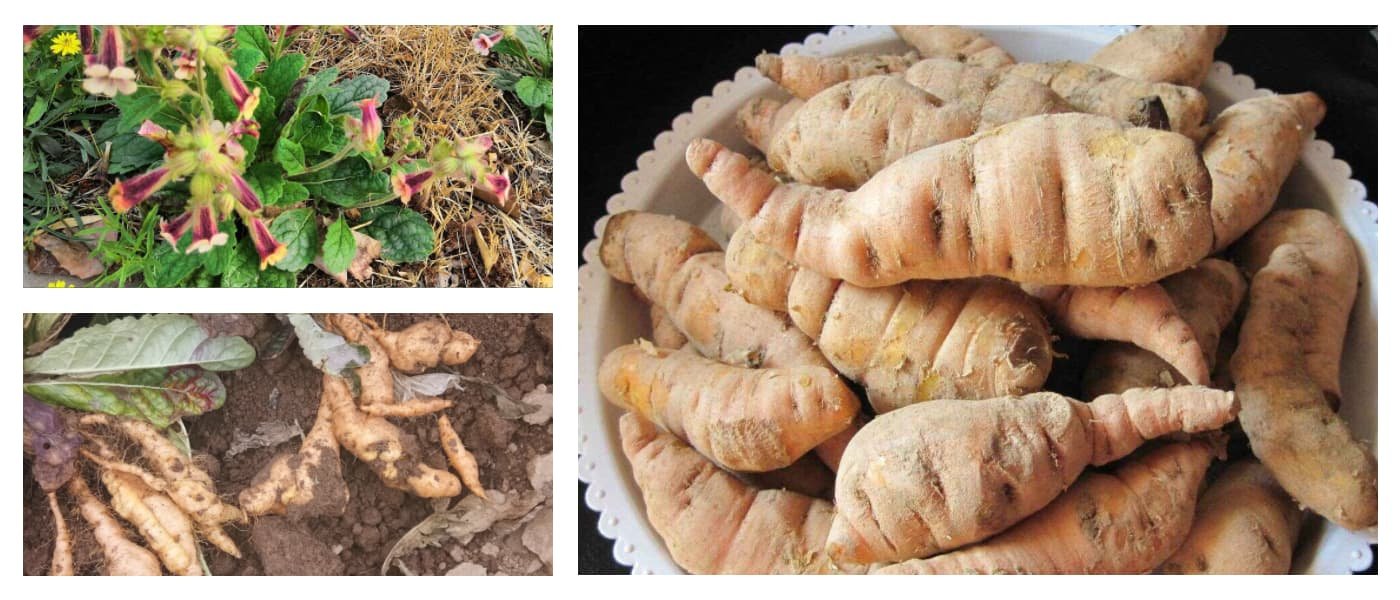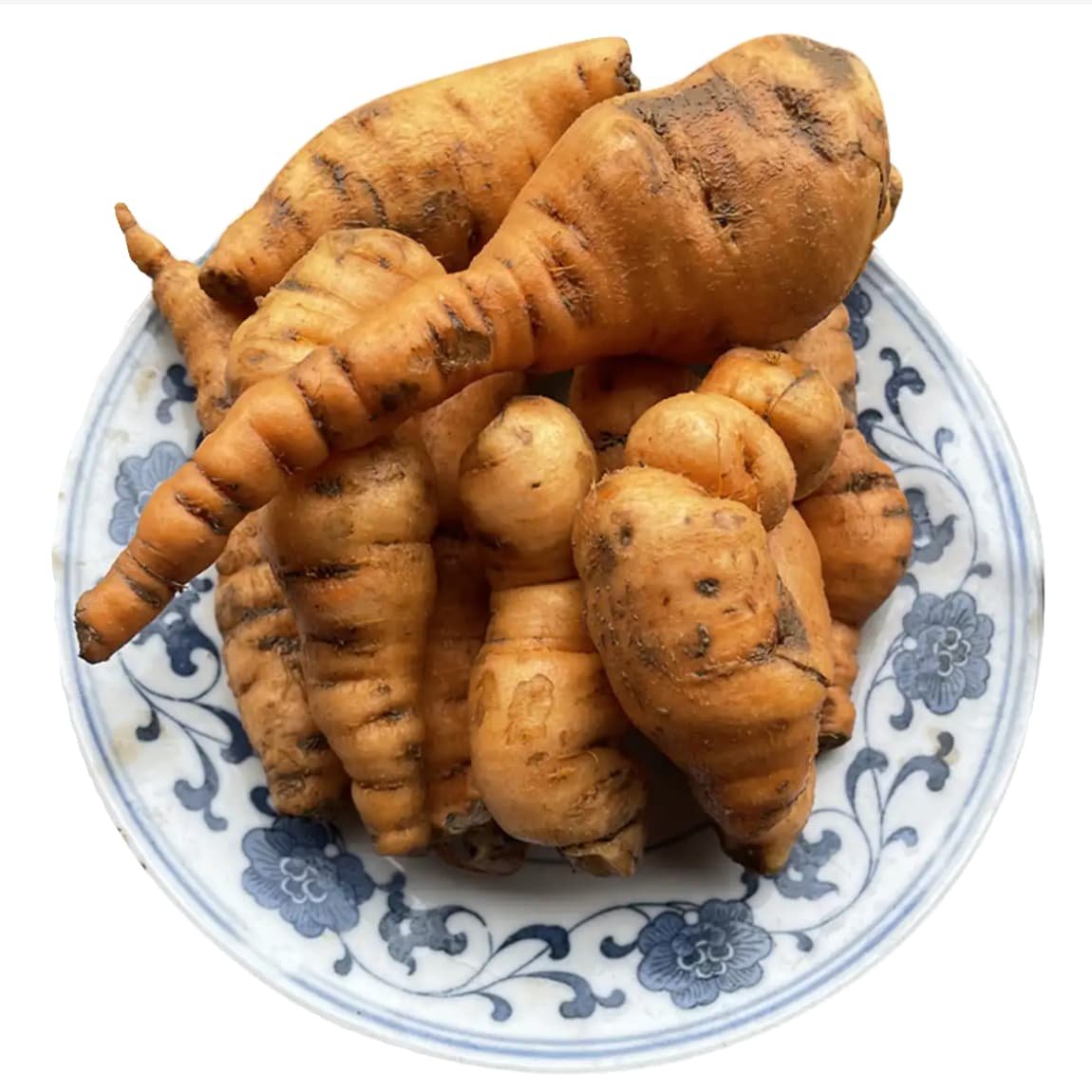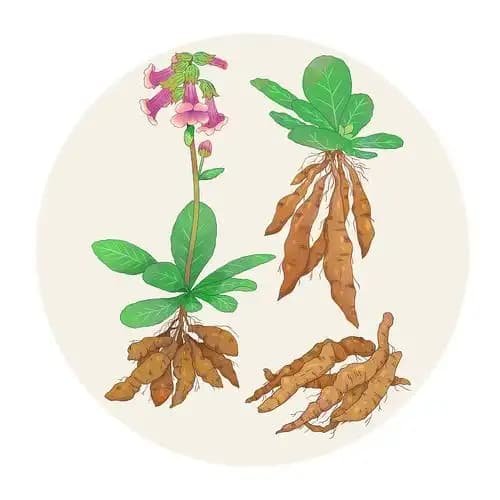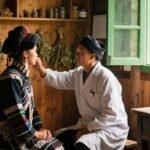Fresh Rehmannia Root (Xian Di Huang)

What is Fresh Rehmannia Root (Xian Di Huang)?
Fresh Rehmannia Root (Xian Di Huang) is the fresh tuberous root of Rehmannia glutinosa (Gaertn.) Libosch. ex Fisch. et Mey., a plant in the family Scrophulariaceae.
Nature and Flavor: Sweet and bitter in flavor, cold in nature.
Meridian Affiliation: Heart, Liver, and Kidney.
It is traditionally used to clear heat and cool the blood, generate fluids, and moisten dryness.
This herb is commonly prescribed for the (used in traditional contexts) of acute febrile diseases, high fever with delirium, skin eruptions, thirst due to fluid depletion, hemorrhagic conditions caused by excessive heat in the blood (e.g., vomiting blood, nosebleeds, uterine bleeding, bloody stools), mouth ulcers, sore throat, tidal fever with cough, traumatic injuries, and abscesses.
What Are the Benefits of Fresh Rehmannia Root (Xian Di Huang)?
Traditional Uses
- Clears heat and cools the blood
- Generates fluids and moistens dryness
It is used for treating:
- Acute febrile illnesses
- Rashes and skin eruptions
- Thirst due to injury to body fluids
- Bleeding caused by blood heat, such as hematemesis, epistaxis, uterine bleeding, hematochezia
- Mouth and tongue ulcers
- Sore and swollen throat
- Tidal fever with cough
- Trauma-related pain and swelling
- Sores and abscesses
Modern Pharmacological Effects
1. Effects on the Immune System
A decoction of Fresh Rehmannia Root (Xian Di Huang) at a dose of 300 mg (crude herb)/mouse/day for 7 consecutive days significantly inhibited the number of Rose Forming Cells (RFC) in the spleen of mice. The RFC count per 10⁶ splenic cells was 5250 in the treated group versus 7500 in the control group.
It also significantly promoted the DNA and protein synthesis of spleen lymphocytes activated by Concanavalin A (ConA), with the optimal concentration for DNA synthesis being 200 μg/ml, peaking at 48 hours.
It enhanced the production of interleukin-2 (IL-2), and the enhancement of DNA, protein synthesis, and IL-2 production followed a parallel trend.
Fresh Rehmannia Root suppressed the proliferation of antigen-binding cells in the mouse spleen, but promoted lymphocyte transformation in humans. When co-cultured with plant lectins or ConA, it facilitated the transformation of splenic lymphocytes in mice.
2. Endocrine Effects
Fresh Rehmannia Root helps normalize the increased number of renal β-receptors in hyperthyroid rats, contributing to the restoration of normal thyroid function.
Studies have confirmed that after (used in traditional contexts) with the herb, the elevated maximal binding capacity of renal β-receptors returned to normal, indicating a molecular mechanism involving modulation of receptor capacity.
Additionally, when administered to rabbits by gavage, it countered the drop in plasma corticosterone caused by continuous dexamethasone use and prevented adrenal cortex atrophy. The thickness of the zona fasciculata and zona reticularis of the adrenal cortex remained within normal ranges.
In rabbits undergoing glucocorticoid therapy, concurrent use of Fresh Rehmannia Root could partially (helps maintain) pituitary-adrenal axis suppression typically caused by corticosteroids.
3. Other Effects
Fresh Rehmannia Root promotes the proliferation and differentiation of pluripotent hematopoietic stem cells (CFU-S) and erythroid progenitor cells (CFU-E) in mice.
In isolated rabbit heart perfusion experiments, doses of 0.2–1.0g reduced coronary flow without affecting heart function. Moderate (0.5g) and high (1.0g) doses slowed heart rate.
How to Use Fresh Rehmannia Root (Xian Di Huang)
- Internal use: Decoction, 10–30g; can also be juiced or prepared as a paste.
- External use: Proper amount, mashed and applied topically, or the juice can be used for direct application.

Precautions and Side Effects
- Incompatible Herbs: Avoid combination with Aconite Root (Chuan Wu) and Cao Niao.
- Dietary Restrictions: Avoid warm or hot foods, animal blood, radish, scallions, and garlic.
- Those with spleen deficiency, poor appetite, or dampness accumulation should use with caution.
Classical Warnings
- Compendium on Processing of Divine Elixirs (Lei Gong Pao Zhi Lun): “Do not let it touch copper or iron utensils. It may damage the kidneys, cause premature graying, and harm the body’s defensive Qi and nutrition.”
- Concise Herbal Foundation Compilation (Bencao Pinhui Jingyao): “Avoid combining with radish, white scallion, Chinese chive, and garlic chive.”
References on Rehmannia glutinosa (Fresh Rehmannia Root)
Phytochemistry and Constituents
1. Oh H, Kim DH, Kim YH, et al. Chemical constituents from the roots of Rehmannia glutinosa. Rec Nat Prod. 2023;17(1):1-8.
View Article
2. Kim JH, Lee JY, Park HJ, et al. Identification of bioactive compounds from the roots of Rehmannia glutinosa. Molecules. 2024;29(24):6009.
View Article
3. Liu C, Ma R, Wang L, et al. Rehmanniae radix in osteoporosis: A review of traditional Chinese medicinal uses, phytochemistry, pharmacokinetics and pharmacology. J Ethnopharmacol. 2017;198:351-362.
View Article
4. Kwak JH, Lee JH, Lee YJ, et al. Phytochemical profiles and antioxidant activity of Rehmannia glutinosa. Chem Biodivers. 2020;17(12):e2000341.
View Article
5. Chang WT, Thissen U, Ehlert KA, et al. Effects of growth conditions and processing on Rehmannia glutinosa using fingerprint strategy. Planta Med. 2006;72(5):458-467.
View Article
6. Jeong EJ, Lee KY, Kim SH, et al. Simultaneous determination of catalpol, aucubin, and geniposidic acid in Rehmannia glutinosa leaves by HPLC. J Anal Methods Chem. 2016;2016:4956589.
View Article
7. Liu Y, Wang Y, Wang L, et al. Phytochemical studies of Rehmannia glutinosa rhizomes. J Med Plants Res. 2024;18(3):123-130.
View Article
8. Dong L, Wang Y, Li H, et al. Cracking the bioactive code of Rehmannia glutinosa: Analysis and functions of its active components. Biol Eng. 2024;12(2):45-60.
View Article
9. Li CY, Zhu ZY, He Y, et al. Chemical analysis and quality evaluation of Rehmannia glutinosa by UPLC-Q-TOF-MS and HPLC methods. Phytochem Anal. 2022;33(4):577-589.
View Article
10. Zhang X, Yang X, Wang L, et al. Chemical constituents from Rehmannia glutinosa with anti-inflammatory activities. Nat Prod Res. 2023;37(5):785-791.
View Article
Pharmacology and Bioactivities
11. Chen X, He L, Lu Y, et al. Evaluating stability and bioactivity of Rehmannia-derived nanovesicles during storage. Sci Rep. 2024;14:70334.
View Article
12. Li Y, Wang Z, Liu Q, et al. Extraction, structure and bioactivities of polysaccharides from Rehmannia glutinosa: A review. J Ethnopharmacol. 2023;116132.
View Article
13. Qiu Y, Zhang H, Wang L, et al. Protective effects of total glycoside from Rehmannia glutinosa on diabetic nephropathy. Front Pharmacol. 2018;9:1012.
View Article
14. Zhang H, Zhang X, Zhu Z, et al. Antioxidant and anti-inflammatory activities of polysaccharides from Rehmannia glutinosa leaves. Int J Biol Macromol. 2021;183:1876-1884.
View Article
15. Huang L, Yuan X, Tian X, et al. Protective effects of catalpol on ischemia/reperfusion injury in rats. Biomed Pharmacother. 2018;106:784-791.
View Article
16. Sun M, Wang W, Guo J, et al. Neuroprotective effects of catalpol against oxidative stress and apoptosis in PC12 cells. Neurochem Res. 2017;42(3):703-711.
View Article
17. Li W, Yang Y, An W, et al. Hepatoprotective effects of Rehmannia glutinosa polysaccharides against CCl4-induced liver injury in mice. Int J Biol Macromol. 2015;78:354-359.
View Article
18. Jiang Y, Nie WJ, Zhang Y, et al. Catalpol: a potential therapeutic agent for Alzheimer’s disease. Curr Med Chem. 2016;23(5):515-528.
View Article
19. Yang J, Chen J, Chen H, et al. Immunomodulatory activities of polysaccharides isolated from Rehmannia glutinosa. Carbohydr Polym. 2015;132:337-344.
View Article
20. Yu S, Jin L, Xiao Y, et al. Catalpol suppresses inflammation in vitro and in vivo by inhibiting NF-κB and MAPK pathways. Med Sci Monit. 2019;25:8490-8498.
View Article
Clinical and Applied Studies
21. Zhang Y, Li J, Wang H, et al. Clinical observation on Rehmannia glutinosa combined with conventional therapy in the (used in traditional contexts) of diabetic nephropathy. J Ethnopharmacol. 2021;267:113532.
View Article
22. Zhao H, Zhang D, Liu Y, et al. Efficacy of catalpol in the management of Alzheimer’s disease: A meta-analysis. Front Aging Neurosci. 2022;14:789321.
View Article
23. Song Y, Zhu Y, Ma J, et al. Effect of Rehmannia glutinosa polysaccharide on glycemic control: A randomized controlled trial. Complement Ther Med. 2020;51:102420.
View Article
24. Liu P, Zhao H, Luo Y, et al. Clinical efficacy of Rehmannia glutinosa formula on osteoporosis: A systematic review and meta-analysis. Phytomedicine. 2020;69:153202.
View Article
25. Huang Z, Yang Y, Lu C, et al. A randomized controlled study of catalpol combined with donepezil in patients with mild to moderate Alzheimer’s disease. Front Pharmacol. 2023;14:1056032.
View Article
26. Wang H, Wang B, Gao X, et al. Protective effects of Rehmannia glutinosa extracts against cisplatin-induced nephrotoxicity in cancer patients. Integr Cancer Ther. 2022;21:15347354221129246.
View Article
27. Sun X, Lin L, Wang Q, et al. Effects of Rehmannia glutinosa decoction on cognitive function and inflammatory markers in elderly patients with vascular dementia. Complement Ther Clin Pract. 2022;47:101565.
View Article
28. Zhang M, Yang L, Wu D, et al. Clinical efficacy of catalpol in post-stroke depression: A double-blind randomized controlled trial. J Affect Disord. 2023;326:94-101.
View Article
29. Zhang R, Wu S, Lu L, et al. Clinical application of Rehmannia glutinosa in the (used in traditional contexts) of chronic kidney disease: A systematic review. Chin Med. 2021;16:82.
View Article
30. Zhou W, Chen H, He Y, et al. A randomized clinical trial of catalpol for the (used in traditional contexts) of ischemic stroke recovery. Stroke Vasc Neurol. 2022;7(6):466-474.
View Article
Chinese Materia Medica (Zhong Hua Ben Cao): Xian Di Huang

Other Names
Raw Rehmannia Root (Sheng Di Huang), Fresh Raw Rehmannia, Shan Yan Gen
Historical Record
Recorded in Illustrated Investigation of Plant Names and Facts
Source
Botanical Origin: The fresh tuberous root of Rehmannia glutinosa (Gaertn.) Libosch. ex Fisch. et Mey.
[syn. Digitalis glutinosa Gaertn.; R. glutinosa Libosch f. huechingensis (Chao et Schih) Hsiao], a plant of the Scrophulariaceae family.
Collection and Storage
Early-harvest Rehmannia is collected in mid-October; late-harvest is collected from late October to early November.
Wild types can also be dug up in spring. During harvest, dig deep and carefully to avoid damaging the root.
Remove stems, crowns, and fine roots, and wash off the soil—this is known as Lu Di Huang.
Alternatively, unwashed roots can be stored in dry sand in a cool, ventilated place.
They can be preserved for 2–3 months and taken out as needed.
Habitat and Distribution
Ecological Environment
Mainly cultivated; wild types grow on hillsides and along roadsides at altitudes between 50–1100 meters.
Geographical Distribution
Found in Liaoning, Inner Mongolia, Hebei, Shanxi, Shaanxi, Shandong, Jiangsu, Anhui, Zhejiang, Henan, Hubei, Hunan, Sichuan, and other regions in China.
Morphology
Rehmannia glutinosa is a perennial herbaceous plant, 10–40 cm tall. Entire plant is covered with gray-white soft hairs and glandular hairs.
Roots are thick, fleshy, and tuberous, cylindrical or spindle-shaped. Stems are erect, simple or branched at the base.
Basal leaves are clustered, obovate-lanceolate, 3–10 cm long, 1.5–4 cm wide, blunt at the tip, tapering at the base into a long petiole, wrinkled surface with irregular serrations.
Stem leaves are smaller. Flower stalks are erect with hairs and form racemes on the upper part of the stem.
Bracts can be leaf-like, well-developed, or degenerated. Calyx is bell-shaped with 5 triangular lobes covered in multicellular hairs and white long hairs with 10 veins.
Corolla is broad-tubular, slightly curved, 3–4 cm long, dark purple outside, yellow inside with purple veins, shallowly 5-lobed at the top and somewhat bilabiate.
Four stamens, two longer than the others, anthers forked at the base. Ovary is superior, ovoid, two-chambered, becoming single-chambered after flowering.
Style single, stigma enlarged. Capsules ovoid or long-ovoid with persistent calyx and style. Numerous seeds.
Flowering season: April–May
Fruiting season: May–June
Cultivation
Biological Characteristics
Prefers warm climate and is relatively cold-tolerant. Best cultivated in sunny fields with deep, loose, fertile, neutral or slightly alkaline sandy loam.
Fertile clay can also be used. Avoid continuous cropping. Best previous crops are grasses; avoid fields previously used for cotton, sesame, legumes, or melons to reduce disease risk.
Cultivation Techniques
Mainly propagated by rhizomes; seeds are used when developing new varieties. Rhizome propagation includes inverted planting, cellar storage, or overwintering in open fields.
Inverted planting yields the highest quality and quantity. In July–August, select robust, disease-free rhizomes from spring crops, cut into 4–5 cm pieces, dry slightly,
and replant in well-fertilized soil at 10–30 cm row spacing and 5–10 cm plant spacing. Weed, fertilize, and drain after rain. Harvest and plant in spring the following year.
Ideal planting temperature is 18–21°C. In Beijing, plant in early to mid-April; in Chongqing, from late February to late March.
Early Rehmannia in Henan is planted in early to mid-April; late Rehmannia (or after wheat harvest) in early May to early June.
Dig furrows 33 cm apart on ridges or beds, place a seed piece every 15–20 cm, cover with 3–4 cm of soil, tamp, and water.
Plant two rows per ridge and 3–4 rows per bed. Thin seedlings on rainy days and keep one healthy seedling per hole.
Before row closure, hoe 2–3 times and remove excess shoots.
Field Management
Fertilize after each hoeing using diluted manure or cake fertilizer. During rainy seasons, ensure drainage to (helps maintain) flooding. Remove flower buds promptly.
Pest and Disease Control
Leaf spot disease: Use resistant varieties and keep fields clean. Apply Bordeaux mixture at early stages.
Other diseases include root wilt, soybean cyst nematode, and ring spot.
Pests include cotton red spider mites—control with 1500x dilution of 40% monocrotophos.
Butterfly larvae can be controlled with pesticides like trichlorfon.
Character Identification
Spindle or rod-shaped, 9–15 cm long, 1–6 cm in diameter. Surface light reddish-yellow with longitudinal wrinkles, horizontal lenticels, and irregular scars.
Fleshy and brittle, cross-section shows pale yellow-white cortex with possible orange-red oil spots, yellow-white xylem with radiating vessels.
Faint aroma, mildly sweet and bitter taste. Preferred specimens are thick, long, and straight.
Microscopic Identification
Cross-section of the root: Cork layer consists of several rows of cork cells. Cortex parenchyma is loosely arranged with many secretory cells containing orange oil droplets.
Occasional stone cells. Few secretory cells in the phloem. Cambium ring well-formed. Broad medullary rays. Vessels are sparse and arranged radially.
Chemical Constituents
Fresh Rehmannia Root (Sheng Di Huang) contains primarily glycosides, especially iridoid glycosides. These include leonuride, aucubin, catalpol, rehmanniosides A, B, C, D, melittoside, geniposide, 8-epiloganic acid, ajugoside, 6-O-E-feruloyl ajugol, 6-O-Z-feruloyl ajugol, 6-O-vanilloyl ajugol, 6-O-p-coumaroyl ajugol, 6-O-(4″-O-α-L-rhamnopyranosyl) vanilloyl ajugol, and jioglutoside A and B. Catalpol has the highest concentration.
Additionally, it contains sugars such as D-glucose, D-galactose, D-fructose, sucrose, raffinose, stachyose, manninotriose, and verbascose, with stachyose being the most abundant, reaching 64.9%.
Amino acids present include lysine, histidine, arginine, aspartic acid, glutamic acid, threonine, serine, glycine, alanine, valine, isoleucine, leucine, tyrosine, phenylalanine, γ-aminobutyric acid, and compounds such as glucosamine, D-mannitol, phosphoric acid, β-sitosterol, daucosterol, 1-ethyl-β-D-galactoside, adenosine, and various inorganic elements.
Pharmacological Effects
1. Effects on adrenal cortex function and cortisol metabolism:
Crude extracts of Fresh Rehmannia Root (equivalent to 8 mg of raw herb) incubated with rabbit liver slices show that it can protect the double bond between C4 and C5 in the A-ring and the ketone group at C3 of cortisol from reduction, as well as (helps maintain) the hydroxyl groups at C17 and C21 and the ketone group at C20 from degradation, thereby delaying hepatic metabolism of cortisol. When used alongside exogenous corticosteroids, it helps maintain plasma cortisol levels near normal, possibly due to competitive inhibition of receptor binding in hepatocytes, thus slowing the uptake and degradation of corticosteroids.
2. Radioprotective effect:
Rats given 1 ml of 100% injectable extract daily for six days showed reduced platelet damage and quicker recovery after exposure to 600Y radiation.
3. Hepatoprotective effect:
Decoctions protect against experimental carbon tetrachloride-induced hepatitis in mice, preventing hepatic glycogen depletion.
4. Hypoglycemic effect:
Early studies report that both subcutaneous (2 g/kg) and oral (4 g/kg) alcohol extracts of Rehmannia (unspecified variety) lower blood glucose in rabbits, particularly via injection. Extracts also inhibit persistent hyperglycemia caused by carbohydrates from Codonopsis root. A 20 g intramuscular dose also counteracts epinephrine-induced hyperglycemia. However, other reports claim only normal rabbit blood sugar is reduced, not epinephrine-induced hyperglycemia. Some preparations failed to reduce blood sugar in rats. A recent study shows that the hot water extract fraction (RG-WP) of the rhizome, rich in pectic polysaccharides, reduced blood glucose in both normal and streptozotocin-induced diabetic mice. It increases hepatic glucokinase and G6PD activity, decreases glucose-6-phosphatase and phosphofructokinase activity, stimulates insulin secretion, and reduces hepatic glycogen.
5. Cardiovascular effects:
A 1% extract shows a significant positive inotropic effect in isolated frog hearts; higher concentrations (2–5%) cause toxicity. In other models, a 2–3% decoction or tincture weakens contraction and output in toad hearts, slows heart rate, and may cause conduction block or arrest. Perfusion experiments on rabbit hearts show 0.2–1.0 g doses reduce coronary flow. At 0.5–1.0 g doses, heart rate is slowed. A 0.33% alcohol extract slows heart rate while increasing coronary perfusion. Rb-86 experiments confirm that 20 g/kg of decoction intraperitoneally increases myocardial perfusion. In toad hindlimb vascular perfusion tests, 1–3% extracts cause vasoconstriction, while 5% causes vasodilation. Intravenous injection in anesthetized dogs raises blood pressure; however, no effect is seen in decerebrate dogs, suggesting a central mechanism. Some reports indicate intravenous decoction or alcohol extract (0.8 g/kg) lowers blood pressure in dogs, but tolerance builds with repeated use.
6. Hemostatic effect:
A yellow crystalline compound from the ethanol extract shortens clotting time in rabbits. Decoction or alcohol extract (10 g/kg), and charred herb taken orally, shorten tail bleeding time in mice.
7. Diuretic effect:
Intravenous extract in anesthetized dogs increases urine output, possibly due to positive cardiac effects and renal vasodilation. Other studies found no diuretic effect in rats.
8. Laxative effect:
Catalpol glycoside exhibits mild delayed laxative action, with an ED50 of 0.34 g/kg in mice.
9. Anti-inflammatory effect:
Daily oral doses (10 g/kg) of decoction or alcohol extract for 5 days significantly reduce formaldehyde-induced paw swelling in rats. Decoction is more effective than alcohol extract.
10. Antifungal effect:
In vitro tests show inhibitory activity against Microsporum canis, Trichophyton mentagrophytes, and Candida species.
11. Immunomodulatory effect:
Treatment of human tonsil cells with 5 mg/ml extract significantly increases interferon production compared to control (P < 0.05), and enhances NDV-induced interferon production (P < 0.001).
12. Other effects:
Oral or intraperitoneal administration (10–20 g/kg) enhances the sedative effect of pentobarbital and protects against hypoxic damage in mice.
Processing
Wash thoroughly to remove soil and impurities, then cut into sections.
Physicochemical Identification
- Take 0.2 g of dried powder, soak in 5 ml water overnight, concentrate supernatant, spot onto filter paper, develop with methanol, spray with 0.2% ethanolic ninhydrin, and dry at 80°C to reveal purple-red amino acid spots.
- Take 1 g of dried powder, soak in 10 ml water overnight. Add 1 ml of supernatant to 2–3 drops of 5% α-naphthol ethanol, shake well, and slowly add 1 ml concentrated sulfuric acid along the test tube wall. A purple-red ring at the interface indicates polysaccharides.
Meridian Affiliation
Heart; Liver; Kidney
Nature and Flavor
Sweet, Bitter; Cold
Precautions
- Contraindicated in individuals with dampness in the spleen and stomach or yang deficiency.
- Compendium of Processing Techniques (Lei Gong Pao Zhi Lun): Avoid metal contact; may deplete kidneys, cause premature greying, and damage Wei-Qi.
- Concise Herbal Foundation Compilation (Bencao Pinhui Jingyao): Avoid radish, scallion, Chinese chives, and garlic.
Functions and Indications
Clears heat and cools the blood; generates fluids and moistens dryness. Used to treat acute febrile disease, high fever with delirium, skin rashes, thirst due to fluid depletion, hemorrhage due to blood heat (hematemesis, epistaxis, uterine bleeding, bloody stools), mouth sores, sore throat, consumptive cough with heat, trauma injuries, and abscesses.
Usage and Dosage
- Internal: Decoction, 10–30 g; or juiced or boiled into paste.
- External: Appropriate amount mashed and applied topically or used as juice to rub affected area.
Compound Formulas
- To treat retained blood due to unresolved sweating in cold or warm diseases, as well as persistent nosebleeds or hematemesis with internal blood stasis, yellowish complexion, black stools: Rhino Horn 30g, Fresh Rehmannia Root (Sheng Di Huang) 240g, White Peony Root (Bai Shao) 90g, Moutan Bark (Mu Dan Pi) 60g. Slice all ingredients finely, decoct in 1800ml water down to 600ml, divide into three doses.
(From: Prescriptions Worth a Thousand Gold, Qian Jin Fang – Decoction of Rhino Horn and Rehmannia) - For summer heat with deficient pulse, restlessness at night, red tongue, occasional delirious speech, eyes remaining open during sleep, or clenching of the jaw: Rhino Horn 9g, Fresh Rehmannia Root (Sheng Di Huang) 15g, Figwort Root (Xuan Shen) 9g, Bamboo Leaf Tip 3g, Ophiopogon Root (Mai Dong) 9g, Salvia Root (Dan Shen) 6g, Coptis Rhizome (Huang Lian) 4.5g, Honeysuckle Flower (Jin Yin Hua) 9g, Forsythia Fruit (Lian Qiao) 6g (use with core). Boil with 8 cups of water to yield 3 cups, take in 3 divided doses. Contraindicated if tongue coating is white and slippery.
(From: Treatise on Epidemic Febrile Diseases, Wen Bing Tiao Bian – Qing Ying Tang) - For blood vomiting and nosebleed due to Yang overwhelming Yin: Raw Lotus Leaf, Raw Mugwort Leaf, Raw Chinese Arborvitae Leaf, Fresh Rehmannia Root (Sheng Di Huang), equal parts. Grind into large pills. Take one pill per dose, decoct in water.
(From: Excellent Prescriptions for Women, Fu Ren Liang Fang – Si Sheng Wan) - For persistent hematemesis: Fresh Rehmannia Juice 200ml, Rhubarb (Chuan Da Huang) 30g (chopped and lightly fried into powder). Combine and decoct down to 100ml. Take in two warm doses after meals.
(From: Formulary of the Beneficial Sage, Sheng Hui Fang) - For lung damage with incessant hemoptysis: Fresh Rehmannia Root (Sheng Di Huang) 240g (pounded for juice), Deer Antler Glue (Lu Jiao Jiao) 30g (toasted and powdered). First decoct 25ml of virgin boy’s urine in a copper vessel, add Rehmannia juice and glue powder, stir well, simmer until fully dissolved (10 boils), divide into three doses.
(From: Comprehensive Records of Sacred Formulas, Sheng Ji Zong Lu – Rehmannia Drink) - To tonify deficiency, clear heat, treat abscesses, carbuncles, and hemorrhoids: Use ample amount of Fresh Rehmannia Root (Sheng Di Huang), crush and press thrice to extract all juice. Simmer the juice in a copper vessel over hot water uncovered until reduced by half. Strain out residue using cloth, reboil into thick syrup. Take a pellet-sized dose with wine three times daily.
(From: Prescriptions Worth a Thousand Gold, Qian Jin Fang – Rehmannia Paste) - For tuberculosis with tidal fever and cough with blood-streaked sputum: Take 20ml of Fresh Rehmannia Juice, mix into nearly cooked white porridge. Stir evenly and take on an empty stomach.
(From: Mirror of Food and Medicine, Shi Yi Xin Jing) - For postpartum uterine bleeding with restlessness: Half a small cup each of Fresh Rehmannia Juice and Chinese Motherwort (Yi Mu Cao), add 1 cup of wine, boil 3–5 times, divide into three doses and take frequently.
(From: Formulary of the Beneficial Sage, Sheng Hui Fang – Rehmannia Wine) - For diabetes (Xiao Ke): Fresh Rehmannia Root (Sheng Di Huang) 1500g (sliced), Fresh Ginger 250g (sliced), Fresh Ophiopogon Root (Mai Dong) 1000g (de-cored). Pound all three together in a stone mortar, strain through cloth to obtain natural juice, simmer over low heat to appropriate thickness. Store in porcelain jar. Take one spoonful with warm water anytime.
(From: Comprehensive Records of Sacred Formulas, Sheng Ji Zong Lu – Rehmannia Syrup) - For trauma from falling off a horse, with severe pain in limbs: Fresh Rehmannia Root (Sheng Di Huang) 500g, Fresh Ginger 160g. Crush into powder, stir-fry with 500g of fermented rice mash, wrap while hot in cloth, apply to injured area. Change when cool. First relieves pain, then helps realign bones.
(From: Records from Yi Jian, Yi Jian Zhi)
Commentaries from Classical Texts
1. Decoction and Syrup Materia Medica (Tang Ye Ben Cao)
Fresh Rehmannia Root (Sheng Di Huang), as used by Qian Zhongyang, is combined with Akebia Stem (Mu Tong) to purge fire from the Small Intestine and guide out red heat. It treats blood heat in the channels, including hematuria and hematochezia, especially when combined with other herbs.
2. Collected Interpretations of Materia Medica (Ben Cao Hui Yan)
This herb is a key tonic for the Kidney and a superior remedy to nourish Yin. It cools and enriches the blood, strengthening the sinews and bones. It treats conditions related to pregnancy and childbirth due to blood deficiency. The Kidney governs the two lower orifices, and blood moistens them, making urination and defecation smooth.
3. New Compilation of Materia Medica (Ben Cao Xin Bian)
Fresh Rehmannia Root (Sheng Di Huang) cools fire in the head and face, clears heat from the Liver and Lungs, and treats reckless bleeding (hematemesis, epistaxis, hematochezia). It should be paired with Schizonepeta (Jing Jie) to guide the herb to its meridian, or with Notoginseng Root Powder (San Qi) to stop bleeding. However, this herb should not be used frequently or for prolonged periods. Once the bleeding stops, warm-tonic herbs should be used instead. Overuse can cool the Spleen and Stomach, cause diarrhea and fatigue, and lead to recurrent bleeding.
4. Origins of the Classic of Materia Medica (Ben Jing Feng Yuan)
According to Ben Cao Bei Lu, Fresh Rehmannia Root (Sheng Di Huang) treats uterine bleeding, postpartum hemorrhage, fetal movement with bleeding, epistaxis, and hematemesis—all through juice ingestion. It also treats trauma and bruising by topical application. Since the Liver stores blood and governs the sinews, unimpeded Liver Qi and Blood allow healing. Its decoction resolves accumulations and cold-heat, harmonizes the blood, and eliminates swellings. It nourishes marrow and muscles by restoring normal Qi and blood flow. It distinguishes clearly between Fresh and Dried Rehmannia, emphasizing their different effects: the fresh form disperses blood while the dried stops bleeding. Using the wrong form can hinder healing.
5. Compatibility-Based Materia Medica (De Pei Ben Cao)
Some claim Fresh Rehmannia Root (Sheng Di Huang) damages the stomach, but it actually stimulates appetite in people with stomach Yin deficiency. In febrile diseases, it promotes sweating and urination to expel pathogens. When fire transforms into phlegm, combining its juice with bamboo sap or ginger juice relieves delirium and rigidity. If Fresh Rehmannia is unavailable, soak Dried Rehmannia Root (Gan Di Huang) in boiling water, extract the juice, and add Bitter Orange (Zhi Ke) or Fritillaria (Chuan Bei) to aid dispersal. Misuse or underuse can cause blockage and Yin depletion.
6. Correct Meanings of Materia Medica (Ben Cao Zheng Yi)
In Ben Cao Bei Lu, the term “great cold” refers to freshly harvested Rehmannia. Juice ingestion is emphasized, distinguishing it from the sun-dried form. It is appropriate for excess fire causing reckless bleeding, but not suitable once blood loss is excessive or Qi is depleted. The herb is not universally applicable to all bleeding cases, especially in postpartum conditions or cases of threatened miscarriage. Though effective at clearing heat and dispersing stasis, excessive cold nature could result in blood coagulation. Fresh Rehmannia Root (Sheng Di Huang) may be externally effective for trauma and swelling, but internally, its strong cold nature might not suit stasis-related conditions. It is essential to understand its proper application rather than generalizing its effects.
7. Supplementary Records of Materia Medica (Ben Cao Bei Lu)
Treats uterine bleeding, postpartum hematemesis, miscarriage with fetal movement, retained placenta, trauma injuries, hematomas, epistaxis, and hematemesis—all through juice ingestion.
8. Treatise on the Properties of Medicinals (Yao Xing Lun)
Clears all forms of heat, breaks blood stasis, promotes menstruation, benefits urination, and disperses abdominal masses. Suitable for patients with deficiency and heat.
9. Dietary Materia Medica (Shi Liao Ben Cao)
Treats toothache, hematemesis, and injuries.
10. Four-Sound Materia Medica (Si Sheng Ben Cao)
Blackens beard and hair.
11. Origins of Medical Learning (Yi Xue Qi Yuan)
Cools blood, moistens skin, expels dampness. Wine infusion enhances upward action.
12. Doctrine of Medicinal Analogies (Yao Lei Fa Xiang)
Cools and enriches the blood, supplements Kidney water and true Yin.
13. Revised Materia Medica (Ben Cao Cong Xin)
Drains fire from the Small Intestine, clears Lung dryness, harmonizes blood disorders, breaks blood stasis, and regulates menstruation. Treats hematemesis, epistaxis, uterine bleeding, toxic dysentery, gastric heat, febrile diseases, measles, extreme thirst, trauma, and promotes urination and defecation.
The information provided on this page regarding traditional Chinese medicinal herbs is for educational and informational purposes only. It is not intended as medical advice, diagnosis, or (used in traditional contexts).



Leave a Reply